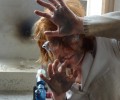There was this old 1993 paper, back when I was doing my fourth year project, where they were making potassium chalcogenides by dissolving the alkali metal in ammonia. It was dangerous. Alkali metals are obviously extremely flammable, and it also involved using very volatile, very toxic condensed ammonia, kept so with a dry ice slurry and extremely low pressures. We were trying to make a product for which the potassium chalcogenide might be a possible precursor. My supervisor looked at the method, and I thought he was going to come up with some super new modern way of doing the reaction safely.
But no.
First I did the reaction with him, then he let me do it by myself, and then he started teaching other students to carry it out.
I think something exploded just under half the time. Usually it was the glass flask that would pop, streaming a fast flow of ammonia into the room, obliging you to dash over to the cylinder and rapidly shut it off before backing away to see if anything else would happen (we probably shut off the vacuum too - I don't remember though). Although it kept going wrong, we were empowered by our initial success with it and my supervisor was convinced that we were all so terrified that we would act with maximum caution... so we kept trying. Afterall, it was fairly reliable in that, although disasters were rife and yields were low, you could pretty much guarantee that if you didn't gas the lab you would get exactly the right product you were aiming for.
But I can't help but wonder what inspired this synthesis the first time round. Did they make a habit of melting alkali metals in liquid ammonia and oohing at the pretty gold colour coming out in the deep blue liquid? Did they throw things in to this witches' cauldron and experiment with what came out as the natural course of their research or were they so determined to make potassium chalcogenides that they were driven to extreme set ups? Because if so, why did they never comment on the safety aspects of it?
We broke so much glassware. And the bigger the experiment, the more likely it was to go wrong, and the more dangerous it was when it did.
On one occasion, my supervisor was in the firing line. I wasn't working with him on this occasion - I was in the next lab down, so the first I knew of it was a shout, running footsteps and, by the time I poked my head out of the door, a host of worried faces and a discarded lab coat lying in the corridor. A few questions were enough to extract the relevant details. He had been leaning over the experiment when it went off, and alkali metal got squirted all over him. This was enough to break his blaise risk attitude - he yelled, ran out of the lab and down the corridor, ripping his lab coat from his body whilst yelling, "AM I ON FIRE?"
He was not on fire. And so the next day, we resumed the experiment.
